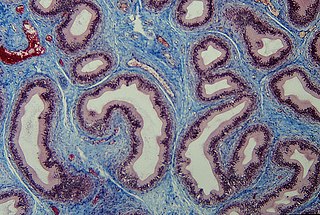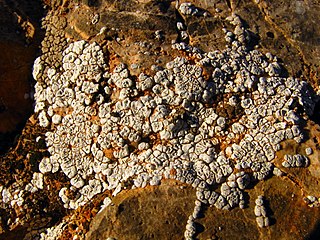
The breast is one of two prominences located on the upper ventral region of a primate's torso. Both females and males develop breasts from the same embryological tissues.

In biology, tissue is a historically derived biological organizational level between cells and a complete organ. A tissue is therefore often thought of as assembly of similar cells and their extracellular matrix from the same origin that together carry out a specific function. Organs are then formed by the functional grouping together of multiple tissues.

A lichen is a composite organism that arises from algae or cyanobacteria living among filaments of multiple fungi species in a mutualistic relationship. Lichens are important actors in nutrient cycling and act as the producers for which many higher trophic feeders feed off of, such as reindeer, gastropods, nematodes, mites, and springtails. Lichens have properties different from those of their component organisms. They come in many colors, sizes, and forms and are sometimes plant-like, but are not plants. They may have tiny, leafless branches (fruticose); flat leaf-like structures (foliose); grow crust-like, adhering tightly to a surface (substrate) like a thick coat of paint (crustose); have a powder-like appearance (leprose); or other growth forms.

Connective tissue is one of the four primary types of animal tissue, along with epithelial tissue, muscle tissue, and nervous tissue. It develops from the mesenchyme, derived from the mesoderm, the middle embryonic germ layer. Connective tissue is found in between other tissues everywhere in the body, including the nervous system. The three meninges, membranes that envelop the brain and spinal cord are composed of connective tissue. Most types of connective tissue consists of three main components: elastic and collagen fibers, ground substance, and cells. Blood, and lymph are classed as specialized fluid connective tissues that do not contain fiber. All are immersed in the body water. The cells of connective tissue include fibroblasts, adipocytes, macrophages, mast cells and leucocytes.

The human areola is the pigmented area on the breast around the nipple. Areola, more generally, is a small circular area on the body with a different histology from the surrounding tissue, or other small circular areas such as an inflamed region of skin.

Loose connective tissue, also known as areolar tissue, is a cellular connective tissue with thin and relatively sparse collagen fibers. Its ground substance occupies more volume than the fibers do. It has a viscous to gel-like consistency and plays an important role in the diffusion of oxygen and nutrients from the capillaries that course through this connective tissue as well as in the diffusion of carbon dioxide and metabolic wastes back to the vessels. Moreover, loose connective tissue is primarily located beneath the epithelia that cover the body surfaces and line the internal surfaces of the body. It is also associated with the epithelium of glands and surrounds the smallest blood vessels. This tissue is thus the initial site where pathogenic agents, such as bacteria that have breached an epithelial surface, are challenged and destroyed by cells of the immune system.

In botany, a cortex is an outer layer of a stem or root in a vascular plant, lying below the epidermis but outside of the vascular bundles. The cortex is composed mostly of large thin-walled parenchyma cells of the ground tissue system and shows little to no structural differentiation. The outer cortical cells often acquire irregularly thickened cell walls, and are called collenchyma cells.

An inverted nipple is a condition where the nipple, instead of pointing outward, is retracted into the breast. In some cases, the nipple will be temporarily protruded if stimulated. Both women and men can have inverted nipples.
The oral mucosa is the mucous membrane lining the inside of the mouth. It comprises stratified squamous epithelium, termed "oral epithelium", and an underlying connective tissue termed lamina propria. The oral cavity has sometimes been described as a mirror that reflects the health of the individual. Changes indicative of disease are seen as alterations in the oral mucosa lining the mouth, which can reveal systemic conditions, such as diabetes or vitamin deficiency, or the local effects of chronic tobacco or alcohol use. The oral mucosa tends to heal faster and with less scar formation compared to the skin. The underlying mechanism remains unknown, but research suggests that extracellular vesicles might be involved.

Ptosis or sagging of the female breast is a natural consequence of aging. The rate at which a woman's breasts drop and the degree of ptosis depends on many factors. The key factors influencing breast ptosis over a woman's lifetime are cigarette smoking, her number of pregnancies, higher body mass index, larger bra cup size, and significant weight change. Post-menopausal women or people with collagen deficiencies may experience increased ptosis due to a loss of skin elasticity. Many women and medical professionals mistakenly believe that breastfeeding increases sagging. It is also commonly believed that the breast itself offers insufficient support and that wearing a bra prevents sagging, which has not been found to be true.

Acarospora is a genus of mostly lichen-forming fungi in the family Acarosporaceae. Most species in the genus are crustose lichens that grow on rocks in open and arid places all over the world. They may look like a cobblestone road or cracked up old paint, and are commonly called cobblestone lichens or cracked lichens. They usually grow on rock, but some grow on soil (terricolous) or on other lichens. Some species in the genus are fungi that live as parasites on other lichens. Acarospora is a widely distributed genus, with about 128 species according to a 2008 estimate.

Acarospora socialis is a usually bright yellow areolate to squamulose crustose lichen in the family Acarosporaceae that grows up to 10 cm wide, mostly on rock in western North America. It is among the most common lichens in the deserts of Arizona and southern California. It grows on sandstone, intrusive and extrusive igneous rock such as granitics, in all kinds of exposures to sunlight, including vertical rock walls. It is found in North America, including areas of the Mojave Desert and Sonoran Desert region, to Baja California Sur. It is the most common yellow member of its genus in southwestern North America. It sometimes, but rarely, grows on other soil crusts. It is a pioneer species.
Caloplaca durietzii, or Durietz's orange lichen, a smooth surfaced yellowish orange crustose areolate lichen with elongated lobes that grows on wood or bark in southwestern North America. It is commonly seen growing on old junipers in Joshua Tree National Monument in the Mojave Desert. It is in the Caloplaca fungus genus of the Teloschistaceae family.

Lecanora muralis(Protoparmeliopsis muralis) is a waxy looking, pale yellowish green crustose lichen that usually grows in rosettes radiating from a center (placodioid) filled with disc-like yellowish-tan fruiting bodies (apothecia). It grows all over the world. It is extremely variable in its characteristics as a single taxon, and may represent a complex of species. The fruiting body parts have rims of tissue similar to that of the main nonfruiting body (thallus), which is called being lecanorine. It is paler and greener than L. mellea, and more yellow than L. sierrae. In California, it may be the most common member of the Lecanora genus found growing on rocks (saxicolous).

Aspicilia phaea is a grayish brown to tan areolate crustose lichen commonly found on rock in coastal to inland parts of central and southern California. Described as new to science in 2007, it is endemic to California. It grows on exposed or partially shaded siliceous rock, with a few known occurrences on serpentine rock.

Candelariella vitellina is a common and widespread green-yellow to orange-yellow crustose areolate lichen that grows on rock, wood, and bark, all over the world. It grows on non-calcareous rock, wood, and bark. It often has tiny lobate areoles in the shape of lion claws. The areoles may be flat or convex. Its sexual reproduction structures (apothecia) are a 0.35–1.0 mm-wide disc, darker yellow than the thallus, rimmed with thallus-like tissue lecanorine, flat but becoming convex with age. Lichen spot tests are K+ reddish, KC−, and C−. It produces calycin, pulvinic acid, pulvinic dilactone and vulpinic acid as secondary metabolites.

Acarospora strigata is an areolate to verruculous crustose lichen that grows on rock around the world, in full sun or shade, and in mesic to arid habitats. It is brown but may appear white or pale gray if it is covered in a pruina. The lichen is common in southwestern deserts of North America.

Acarospora fuscata is a glossy pale or yellowish-brown areolate lichen with angular areolas that grows up to 10 cm (4 in) wide on non-calcareous rock in low and high elevations. It grows in Europe and North America. It grows in southern California and on the eastern part of the Sierra Nevada range. It may grow with the areolas disconnected. The areolas may lift at the edges, but the areolas do not overlap like true squamules (sub-squamulose). More common in the Sierras is the similar species Acarospora thamnina, which is truly squamulose with overlapping scales.

Aspicilia cinerea is a gray to almost white, 1.5 – 15 cm wide, crustose areolate lichen with large apothecia that mostly grows on rock in the mountains. It grows in variable forms, from having a continuous surface to being areolate. It grows in Eurasia, and North America on siliceous rock, schist or igneous rock in habitats exposed to sunlight, also rarely on calciferous rock. It is common in Arizona, and rare in California and Baja California at elevations of 1,700 to 3,300 metres.

Thalassiosiraceae is a family of diatoms in the order Thalassiosirales. The family of Thalassiosiraceae have the unique quality of having a flat valve face. These diatoms are common in brackish, nearshore, and open-ocean habitats, with approximately the same number of freshwater and marine species. Thalassiosiraceae are a centric diatom full of fultoportula. These can often be mistaken for Areola. These belong to many diatom families and can be found in different forms such as the different Areolae that can be found on Navicula or Gomphoneis known as lineolate and punctate. Unlike naviculaceae who are symmetrical in shape some Thalassiosiraceae take on being tangentially undulate.

















